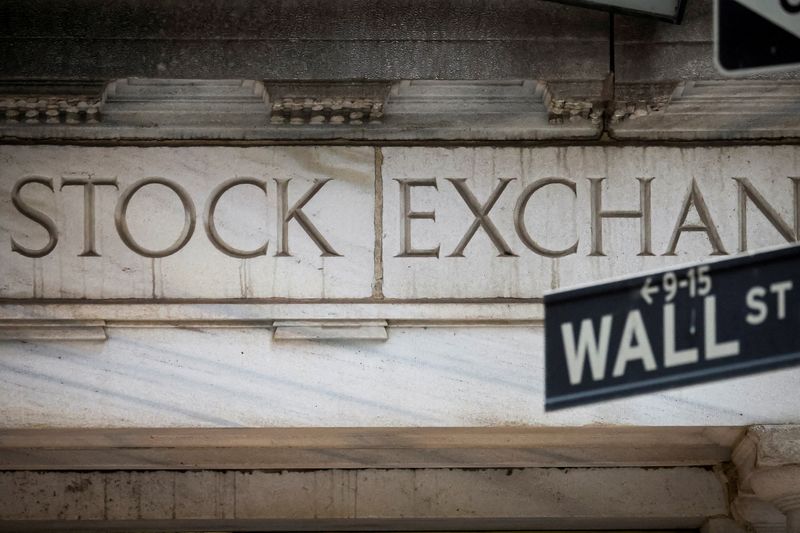 © Reuters. FILE PHOTO: The Wall Street entrance to the New York Stock Exchange (NYSE) is seen in New York City, U.S., November 15, 2022. REUTERS/Brendan McDermid/File Photo
© Reuters. FILE PHOTO: The Wall Street entrance to the New York Stock Exchange (NYSE) is seen in New York City, U.S., November 15, 2022. REUTERS/Brendan McDermid/File Photo
By David French
(Reuters) - Wall Street's main indexes posted their biggest weekly drop of 2023 after sharp losses on Friday, as investors braced for the possibility of more aggressive rate hikes from the U.S. Federal Reserve as U.S. economic data pointed to resilient consumers.
For the blue-chip Dow Jones Industrial Average, the 3% fall was its biggest weekly decline since September. It was also the Dow's fourth straight weekly decline, its longest losing streak for nearly 10 months.
The S&P 500 and Nasdaq Composite were also down 2.7% and 3.3%, respectively.
After a strong January, stocks have retreated this month as a slew of economic data amplified worries that the U.S. central bank might have to keep rates higher for longer.
Data on Friday showed the personal consumption expenditures (PCE) price index, the Fed's preferred inflation gauge, shot up 0.6% last month after gaining just 0.2% in December. Consumer spending, which accounts for more than two-thirds of U.S. economic activity, jumped 1.8% last month, exceeding forecasts for a 1.3% rise.
Jason Pride, chief investment officer of private wealth at Glenmede, said previous market cycles had witnessed similar delayed reactions by the market to rising interest rates and data releases, which helps explain volatile trading patterns as investors slowly adjust.
"This market has not yet realized the likelihood of a recession that we think is reality," he said, noting past rate hikes normally had taken between six and 18 months before their effects had fully filtered through into the economy.
"We don't think (a recession is) a given, but there's a higher likelihood than the market has embedded in its thought process."
Traders of futures tied to the Fed's policy rate added to bets of at least three more rate hikes this year, with the peak rate seen in the range of 5.25%-5.5% by June.
Cleveland Fed President Loretta Mester said the Fed should raise interest rates higher than necessary if need be to get inflation fully under control.
The Dow Jones Industrial Average fell 336.99 points, or 1.02%, to 32,816.92, the S&P 500 lost 42.28 points, or 1.05%, to 3,970.04 and the Nasdaq Composite dropped 195.46 points, or 1.69%, to 11,394.94.
Nine of the 11 major S&P sectors fell, with real estate, technology and consumer discretionary the biggest decliners. Communication services fell 1.4% to a sixth straight loss, its worst run since a similar six-session skid in August.
Megacap stocks including Tesla (NASDAQ:TSLA) Inc, Amazon.com Inc (NASDAQ:AMZN) and Nvidia (NASDAQ:NVDA) Corp slid between 1.6% and 2.6% as Treasury yields rose. [US/]
The yield on two-year Treasury notes, which are highly sensitive to Fed policy, climbed to 4.826% - its highest in nearly four months. [US/]
Boeing (NYSE:BA) Co slid 4.8% after the Federal Aviation Administration said the planemaker temporarily halted deliveries of its 787 Dreamliner jets.
Adobe (NASDAQ:ADBE) Inc sank 7.6% on reports the U.S. Justice Department would block the Photoshop maker's $20 billion bid for cloud-based designer platform Figma.
The decline in Adobe's stock was the largest since Sept. 15, the day the Figma agreement was announced.
Meanwhile, Range Resources Corp (NYSE:RRC) jumped 11.9% in late trading, its biggest gain in nine months, after Bloomberg News reported that Pioneer Natural Resources (NYSE:PXD) was in talks to buy it. Pioneer's stock fell 4.1% on the report.
Volume on U.S. exchanges was 10.31 billion shares, compared with the 11.53 billion average for the full session over the last 20 trading days.
The S&P 500 posted 2 new 52-week highs and 11 new lows; the Nasdaq Composite recorded 44 new highs and 162 new lows.

